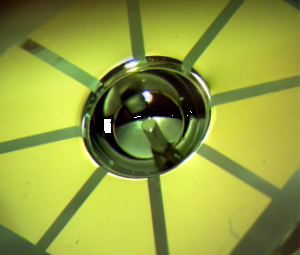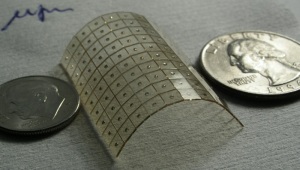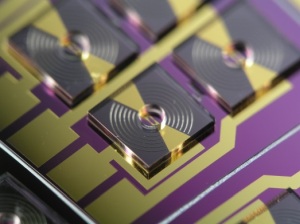MEMS

Your MEMS R&D Partner
At Tanner Laboratories, we provide low cost MEMS prototyping services to our government, academic, and commercial partners. We have an in-house clean room (300 sq ft. class 100 litho bay and two class 1000 bays; total area ca. 1100 sq ft.) fully staffed with scientists and engineers spanning a broad range of discipline (traditional and non-traditional MEMS, CMOS design, modeling and control systems).
Public Examples of Our Projects
Bulk Metallic Glass (BMG) Inertial Sensors
Recently with the Schroers’ group at Yale University, we have demonstrated the first surfaced micromachined electrostatic sensors and actuators. The lossless nature of amorphous glass also allows unprecedented performance for wine glass gyros.
Microfluidics
We are experts in creating multi-level fluidic structures in polymers such as Parylene and SU-8. Parylene allows multi-layers fluidics as well as the ability to create flexible sensor skins(see above). SU-8 enables structures as tall as 300+ microns which can serves as wells for chemicals. Our customers have used these devices for mass spectrometry, cell sorting, pumping, and pressure measurements.
Micro-cavities
With SU-8 and other polymers ultra thicks features enable micro cavities which could be used for liquid dosing, energetics, and other micro-fluidic applications.
Electrowetting
With our Keck team members we have fabricated embedded hydrophobic electrodes and circuitry that enable user controlled motion of liquid droplets. This control of small liquid volumes is used for chemistry and biological applications. (Videos courtesy Keck Graduate Institute/Tanner Research)
Printed Circuit Board (PCB) MEMS
We think out of the box for our customers. While MEMS devices are typically made on silicon and glass, we have developed a MEMS low temperature process that allows us to create actuation structures on PCBs.
Optical Communications
Tanner Labs has also developed with MOICS (MEMS-based Optical Identification and Communication System), a technology that could provide secure communication between an interrogator and a compact, lightweight, and robust remote unit. The key component is the micro-cornercube reflector (CCR) on the remote unit.


